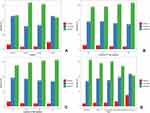Back to Journals » Risk Management and Healthcare Policy » Volume 13
Meteorological Condition and Air Pollution Exposure Associated with Vitamin D Deficiency: A Cross-Sectional Population-Based Study in China
Authors He H , Zeng Y, Wang X, Yang L , Zhang M, An Z
Received 22 July 2020
Accepted for publication 28 September 2020
Published 29 October 2020 Volume 2020:13 Pages 2317—2324
DOI https://doi.org/10.2147/RMHP.S273145
Checked for plagiarism Yes
Review by Single anonymous peer review
Peer reviewer comments 3
Editor who approved publication: Professor Marco Carotenuto
He He,1,* Yuping Zeng,1,* Xia Wang,1 Lidan Yang,1 Mei Zhang,1 Zhenmei An2
1Department of Laboratory Medicine, West China Hospital, Sichuan University, Chengdu, People’s Republic of China; 2Department of Endocrinology and Metabolism, West China Hospital, Sichuan University, Chengdu, People’s Republic of China
*These authors contributed equally to this work
Correspondence: Mei Zhang Department of Laboratory Medicine
West China Hospital, Sichuan University, No. 37, Guoxue Lane, Chengdu, People’s Republic of China
Email [email protected]
Objective: The aim of this study was to investigate the status of Vitamin D deficiency and the effect of environmental factors on Vitamin D levels so as to provide theoretical support for public health promotion in this region.
Methods: A total of 22,387 subjects who underwent a physical examination at the center in the West China Hospital, Sichuan University, between April, 2018 and May, 2020 were enrolled in this study. Their data on gender, age, inspection date, serum 25 hydroxyvitamin D (25-(OH) D), parathyroid hormone (PTH), and total calcium were retrospectively reviewed. Next, the percentage of Vitamin D status was compared in different sex and age groups, and the fluctuation of Vitamin D level was described in relation to the change of environment. Finally, the univariable and multivariable linear regression analyses were performed to explore the risk and protective factors of Vitamin D deficiency.
Results: The proportion of Vitamin D deficiency in this area was 42.17%, and it was significantly higher among women and young people. The fluctuation trend of 25-(OH) D levels are consistent with temperature and solar radiation, and opposite to air quality, in the whole year. There was a positive relationship between 25-(OH) D levels with temperature and solar radiation; however, parathyroid hormone, female and AQI were negatively correlated with Vitamin D levels.
Conclusion: Vitamin D deficiency is common in subtropic areas, such as Sichuan Basin, which is related to solar radiation and air pollution.
Keywords: Vitamin D deficiency, 25 hydroxyvitamin D, environmental factors, air quality index
Introduction
Vitamin D is beneficial for the human body as it participates in the intake and use of calcium and phosphorous. Also, it has a critical role in regulating immunity and cell growth.1 Vitamin D deficiency (VDD) is related to the general mortality of the population and the vast majority of illnesses, including osteoporosis, fractures, rickets in children, osteomalacia in adults, cardiovascular disease, inflammation, cancers, and so on.2–4 Serum total 25-(OH) D, a stable and abundant metabolite, is commonly used to assess the levels of Vitamin D in humans.5 Zhang et al reported that although vitamin D supplementation was not significantly associated with a reduction in all-cause mortality, it can reduce the risk of cancer death.6 Currently, most existing studies have focused on the elderly, suggesting that low levels of Vitamin D are negatively correlated with all-cause mortality. However, there is a lack of research on the relationship between Vitamin D deficiency and all-cause mortality in young people in relation to all important confounding factors.7
Many diseases have been recognized to occur as the results of environmental factors. Personal health status is threatened by the growing urbanization, intercity automobile use, climate change, and air pollutants.8,9 It has been demonstrated that exposure to a harmful environment increases mortality and morbidity, outpatient visits, and hospitalizations and decreases the life expectancy of the influenced population.10,11 Based on the relationship between 25-(OH) D levels and environmental factors, we aimed to determine whether the meteorological condition and air pollution exposure contribute to or accelerate the progression of VDD. In this study, we evaluated the situation of VDD in Western China and the impact of environmental factors on the levels of Vitamin D in this population so as to provide theoretical support for public health promotion in this region.
Materials and Methods
Study Subjects
A total of 22,387 subjects who underwent a physical examination at the center in the West China Hospital, Sichuan University, between April, 2018 and May, 2020 were included in this study. All subjects were between 18 and 60 years old with complete records of essential information and laboratory results. All the subjects suffering from cancers, organ failure, abnormal liver and kidney function, osteoporosis/fractures, cardiovascular diseases, and endocrine and metabolic diseases were excluded. The data on gender, age, inspection date, serum 25-(OH) D, parathyroid hormone (PTH), and total calcium (TCa) were collected from the laboratory information system (LIS). Also, exceptional data were treated as missing values (Figure S1). The study received approval from the Ethics Committee on Biomedical Research, West China Hospital of Sichuan University (Approval No: 977 (2019)). At the same time, the Ethics Committee accordance with the principles stated in the Declaration of Helsinki approved the waiver of informed consent because of the following reasons. Firstly, we obtained the medical records in this study from previous clinical diagnosis and treatment of repository in the laboratory information system, and consent would be impossible or impracticable to obtain for such research. Secondly, the waiver of informed consent did not adversely affect the rights and health of the subjects. Thirdly, the privacy and data of the subjects are confidentiality. Finally, this study does not involve medical records that the subjects have explicitly refused before.
Laboratory Testing
All the serum samples were collected from the elbow vein after 8~12 hour fasting and separated after centrifuging at 3500 rpm for 8 minutes. Serum 25-(OH) D and PTH were measured by electrochemiluminescence method and run in the Roche Cobas e601 (Mannheim, Germany). Serum total calcium (TCa) was measured by O-cresolphthalein ketone colorimetric method and analyzed using Roche Cobas c702 (Mannheim, Germany). The coefficient of variation for low-quality control and high-quality control of 25(OH)-D was 6.32% and 4.86%, PTH was 3.72%, and 3.33%, and TCa was 1.39% and 1.04%, respectively. All tests were completed by Roche original reagents and calibrators and were used for an external quality assessment accredited by the College of American Pathologists (CAP) and National Center for Clinical Laboratories (NCCL) of China with the bias of 6.3% for 25-(OH) D, 5.8% for PTH and 0.8% for TCa that indicated that the test results were accurate and reliable.
Environment Factors
Daily total radiation and net radiation (2018.04–2019.11) were downloaded from the China Meteorological Data Network (http://data.cma.cn/site/index.html). Daily Air Quality Index (AQI) (2018.04–2020.05) was downloaded from the air quality online monitoring and analysis platform (https://www.aqistudy.cn/). According to the recommendations, there are six levels of AQI (Table S1).9,12
Statistical Analysis
The Kolmogorov–Smirnov statistic, histogram, and quantile-quantile plot (Q-Q plot) were used to test for the normality of variables. Abnormal 25-(OH) D, PTH, and TCa values were excluded by the criteria of more than three times the interquartile range. Chinese experts suggested that Chinese health practitioners should adopt the same views as those accepted by the American Academy of Medical Sciences, the British Osteoporosis Society, and the Australian Bone Mineral Association. Accordingly, subjects were divided into three groups with the 25-(OH) D values: less than 29.9 nmol/L (deficient), 30–49.9 nmol/L (insufficient), greater than 50 nmol/L (sufficient).13 We compared the percentage of the three groups in relation to different sex and age by using the Chi-square test. We also compared the three groups in quantile of total radiation, net radiation, season, and AQI groups. Univariable and multivariable linear regression and the collinear diagnosis were used to explore the potential influence factors of Vitamin D status. Independent variables included sex, age, season, AQI, and total radiation. We also calculated the median of 25-(OH) D, PTH, TCa, temperature, total radiation, and AQI per month and drew a time variation curve to show how variables fluctuate over time. All analyses were performed by the R software (version 3.6.3). A P-value of <0.05 was considered statistically significant.
Results
Prevalence of Vitamin D Deficiency
We investigated the serum 25-(OH) D levels to evaluate the VDD in this area, where the normality test showed that the level of 25-(OH) D in this area was an approximately normal distribution (Figure S2). There were 42.17% of subjects who had Vitamin D deficiency or insufficient levels of Vitamin D. The results showed that the morbidity rates of VDD and Vitamin D insufficiency were significantly higher in females (51.6%) than in males (34.1%). The proportion of Vitamin D sufficiency was significantly lower in females compared to males. Moreover, there were differences in the ratio of VDD among different age groups. The most challenging situation was found among people aged 20 to 30 years old, 48.7% of whom were Vitamin D insufficient, and 10.7% had VDD. People aged 50 to 60 years old showed to have the most favorable condition since 67.4% of them were Vitamin D sufficient. Their morbidity rates of Vitamin D insufficiency and deficiency were 29.4% and 3.2%, respectively. The details of Vitamin D deficiency across different gender and age are shown in Table 1.
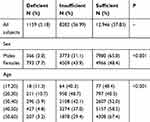 |
Table 1 The Prevalence of Vitamin D Deficiency in West China |
Factors Influencing Serum 25-(OH) D Levels
We analyzed the fluctuations of serum 25-(OH) D levels in the crowd. The average levels of 25-(OH) D were 53.2 nmol/L, and the levels in males were higher than those in females. Besides, with reference to Vitamin D sufficiency, insufficiency, and deficiency, 25-(OH) D levels increased with age. The details are shown in Table 2.
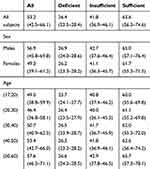 |
Table 2 The 25-OH-Vitamin D Levels (Nmol/L) in Different Groups |
The line graph demonstrated the fluctuations in 25-(OH) D levels over a year in West China. According to the chart, the 25-(OH) D levels significantly increased from January to October, when they reached the peak. Although it was sometimes fluctuating, the overall trend was upward. The 25-(OH) D levels decreased between October and December, and the lowest point of the year was in January. In contrast, the yearly trend of PTH was opposite to 25-(OH) D, and the overall fluctuation range of PTH was relatively small. The overall fluctuation trend of serum total calcium was similar to that of Vitamin D, and the peak value occurred slightly later than that of Vitamin D. Next, to explore the factors impacting on the VDD, we evaluated the relationships between environment and 25-(OH) D levels. Based on the time variation curve, we found that the fluctuation of 25-(OH) D is also related to AQI and radiation. 25-(OH) D was the lowest in January, which was the valley value of temperature and total radiation and the peak value of AQI (Figure 1). For AQI, summer is unique in this area. Every year, AQI reaches a second peak in August.
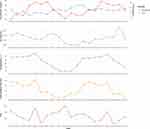 |
Figure 1 The fluctuations of Vitamin D levels throughout a year with different environmental factors. |
Finally, we described the time variation curve of specific pollutants and 25-(OH) D levels. In August, the primary pollutant was O3. Although stratospheric ozone can absorb ultraviolet rays and reduce solar radiation, ozone pollution had relatively little effect on Vitamin D levels at that time (Figure S3).
Prevalence of Vitamin D Deficiency in Different Environments
The proportion of Vitamin D sufficient was highest in summer and lowest in winter; on the contrary, the percentage of Vitamin D deficiency and insufficiency was lowest in summer and most elevated in winter (Figure 2A). The proportion of Vitamin D sufficiency grows with the increase of total radiation. In contrast, the percentage of Vitamin D insufficiency and deficiency decreased, just as the effects of net radiation (Figure 2B and C). Besides, the impact of air pollution on VDD was slightly different. The proportion of varying Vitamin D status in the AQI of good and light pollution was similar. Besides, with the aggravation of AQI, the portion of VDD increased (Figure 2D).
Risk Factors of Vitamin D Deficiency
Univariable and multivariable linear regression showed that males had higher levels of 25-(OH) D than women and 25-(OH) D levels increased with age. With reference to the seasons, there was a negative relationship with 25-(OH) D levels in spring and winter compared with summer, but a positive relationship with autumn. Besides, 25-(OH) D levels were negatively correlated with AQI and positively correlated with total radiation (Table 3).
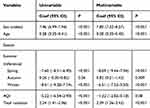 |
Table 3 Univariable and Multivariable Linear Regression of VD |
Discussion
Vitamin D deficiency is a common occurrence worldwide and a public health problem that is especially evident in low and lower-middle-income countries.14 According to the World Bank Group’s per capita gross national income, China is classified as a developing economy, which is especially evident in the western region of China, where the average level is lower than that of the whole country.15 Over recent years, the attempts to promote economic development have been inevitably accompanied by some environmental damage. Environmental factors, including climatic conditions, solar radiation, and environmental pollution, have been given serious attention considering their impact on human health.16 Some epidemiological studies showed that air pollution might be the potential risk factor for Vitamin D deficiency.17 In this study, we analyzed the time variation curve of 25-(OH) D levels under different conditions and the constituent ratio of VDD. We also explored the environmental factors that impact VDD in this region.
It has been previously reported that females and young populations have an increased prevalence of VDD.18 Other studies19,20 have suggested that if older people are excluded from taking Vitamin D supplements, their average level of 25-(OH) D is lower, and VDD is more severe.21 Because of the decreased concentrations of 7-dehydrocholesterol, the ability to make Vitamin D through the skin decreases in older people. However, our results confirmed that the female gender and younger age were the risk factors of Vitamin D insufficiency and deficiency. In subtropic areas, young people have a higher rate of Vitamin D intake;18 yet, their Vitamin D levels were still low, which may be related to sun exposure. In these areas, the young tend to spend more time working, studying, and even exercising indoor, while the elderly prefer outdoor sports. Further, young girls like to use sunscreen and other cosmetics to reduce sun exposure, which results in less exposure to the sun.22,23
The findings of our research on Vitamin D deficiency in the population of Sichuan Province, Western China indicated that about 42.17% of the population had insufficient levels of vitamins in the body, and the average levels were 53.22 nmol/L, which is comparable to the national level.24–26 However, China has a vast territory, and environmental factors are entirely different across different regions, even at the same latitude or longitude. Sichuan Basin is located in the upper reaches of the Yangtze River in Southwest China. Because of the plateau mountains, its topography is unique, and the height difference is significant, the climate is more complicated than in other regions, with substantial regional climate characteristics. The subjects included in this study mainly live in the subtropical monsoon humid climate, which is characterized by early spring, hot summer, cool autumn, and warm winter. Consistent with most studies, our findings showed that with the decrease in temperature and solar radiation, the level of 25-(OH) D decreased. As temperature and radiation levels rise, 25-(OH) D levels increase.27,28
The particular geographical factors and specific climate characteristics led to the environmental pollution of this region being different from that of other areas.29,30 The prevalence of VDD is highest in winter, which is related to lower temperatures, radiation, and severe air pollution. The 25-(OH) D levels were positively related to temperature and radiation. Nevertheless, they were negatively associated with AQI. The multivariable linear regression also showed that winter and air pollution were the risk factors for Vitamin D insufficiency and deficiency. Hoseinzadeh et al reviewed the literature and suggested that air pollutants inhibit the absorption of Vitamin D by affecting solar radiation, which eventually leads to VDD in the population.17 Yet, in this area, due to the unique geographical conditions of the basin, air pollution peaks every summer. During this period, the annual temperature and radiation levels are the highest. However, Vitamin D levels are still slightly affected, showing a downward trend and returning to the peak level in October. Therefore, we thought that the impact of air pollution is not immediate, and there may be a potential mechanism through which Vitamin D levels get directly affected by air pollution.31 Similarly, the regression analysis also showed that compared with summer, the Vitamin D levels in autumn were higher, which may also be related to the severe ozone pollution in August, considering the radiation and temperature in this month are the highest throughout the year.
Conclusion
Vitamin D deficiency is common in the subtropics areas such as Sichuan Basin. The prevalence of Vitamin D deficiency tends to vary from season to season due to variations in temperature, solar radiation, and air pollution. Different pollutants have different effects on Vitamin D levels, and further multicenter studies are needed to prompt public health efforts.
Abbreviations
VDD, Vitamin D deficiency; 25-(OH) D, 25 hydroxyvitamin D; PTH, parathyroid hormone; TCa, total calcium; AQI, Air Quality Index; PM2.5, fine particulate matter; PM10, inhalable particles; SO2, sulfur dioxide; NO2, nitrogen dioxide; O3, Ozone; CO, carbon monoxide.
Data Sharing Statement
Daily total radiation and net radiation (2018.04-2019.11) were downloaded from the China Meteorological Data Network (http://data.cma.cn/site/index.html). Daily Air Quality Index (AQI) (2018.04-2020.05) was downloaded from the air quality online monitoring and analysis platform (https://www.aqistudy.cn/). The data, including gender, age, inspection date, serum 25-(OH) D, and PTH, were collected from the laboratory information system (LIS), and it can be obtained with the consent of the corresponding author.
Compliance with Ethical Standards
The study received approval from the Ethics Committee of West China Hospital, Sichuan University (Approval No: 977 (2019))
Acknowledgments
Thanks for the fund of the National Natural Science Foundation of China (81902142), the Sichuan Science and Technology Department (2020YFS0096, 2020YFH0114).
Disclosure
The authors report no conflict of interest.
References
1. van Driel M, van Leeuwen JP. Vitamin D endocrinology of bone mineralization. Mol Cell Endocrinol. 2017;453:46–51. doi:10.1016/j.mce.2017.06.008
2. Nikolac Gabaj N, Unic A, Miler M, et al. In sickness and in health: pivotal role of vitamin D. Biochem Med. 2020;30(2):020501. doi:10.11613/BM.2020.020501
3. Savastio S, Pozzi E, Tagliaferri F, et al. Vitamin D and cardiovascular risk: which Implications in Children? Int J Mol Sci. 2020;21(10):3536.
4. Martens PJ, Gysemans C, Verstuyf A. Vitamin D’s effect on immune function. Nutrients. 2020;12(5):1248.
5. Cashman KD, Kiely ME, Andersen R, et al. Individual participant data (IPD)-level meta-analysis of randomised controlled trials with vitamin D-fortified foods to estimate dietary reference values for vitamin D. Eur J Nutr. 2020:1–21.
6. Zhang Y, Fang F, Tang J, et al. Association between vitamin D supplementation and mortality: systematic review and meta-analysis. BMJ. 2019;366:l4673.
7. Rush L, McCartney G, Walsh D, MacKay D. Vitamin D and subsequent all-age and premature mortality: a systematic review. BMC Public Health. 2013;13(1):679. doi:10.1186/1471-2458-13-679
8. Stauber C, Adams EA, Rothenberg R, et al. Measuring the Impact of Environment on the Health of Large Cities. Int J Environ Res Public Health. 2018;15(6):1216.
9. Shen F, Zhang L, Jiang L, et al. Temporal variations of six ambient criteria air pollutants from 2015 to 2018, their spatial distributions, health risks and relationships with socioeconomic factors during 2018 in China. Environ Int. 2020;137:105556. doi:10.1016/j.envint.2020.105556
10. Hahad O, Lelieveld J, Birklein F, Lieb K, Daiber A, Münzel T. Ambient air pollution increases the risk of cerebrovascular and neuropsychiatric disorders through induction of inflammation and oxidative stress. Int J Mol Sci. 2020;21(12):4306.
11. Liu J, Wu T, Liu Q, Wu S, Chen JC. Air pollution exposure and adverse sleep health across the life course: a systematic review. Environ Pollut. 2020;262:114263. doi:10.1016/j.envpol.2020.114263
12. Luo H, Guan Q, Lin J, et al. Air pollution characteristics and human health risks in key cities of northwest China. J Environ Manage. 2020;269:110791. doi:10.1016/j.jenvman.2020.110791
13. Holick MF, Binkley NC, Bischoff-Ferrari HA, et al. Evaluation, treatment, and prevention of vitamin D deficiency: an endocrine Society clinical practice guideline. J Clin Endocrinol Metab. 2011;96(7):1911–1930. doi:10.1210/jc.2011-0385
14. Cashman KD, Sheehy T, O’Neill CM. Is vitamin D deficiency a public health concern for low middle income countries? A systematic literature review. Eur J Nutr. 2019;58(1):433–453. doi:10.1007/s00394-018-1607-3
15. World Economic Situation and Prospects 2020. 2020. Available from: https://www.un.org/development/desa/dpad/publication/world-economic-situation-and-prospects-2020/.
16. Zhao H, Li X, Zhang Q, et al. Effects of atmospheric transport and trade on air pollution mortality in China. Atmos Chem Physi. 2017;17(17):10367–10381. doi:10.5194/acp-17-10367-2017
17. Hoseinzadeh E, Taha P, Wei C, et al. The impact of air pollutants, UV exposure and geographic location on vitamin D deficiency. Food Chem Toxicol. 2018;113:241–254. doi:10.1016/j.fct.2018.01.052
18. Lee M-J, Hsu H, Wu W, Sun C-Y, Ting M-K, Lee -C-C. Vitamin D deficiency in northern Taiwan: a community-based cohort study. BMC Public Health. 2019;19(1):337. doi:10.1186/s12889-019-6657-9
19. Daly RM, Gagnon C, Lu ZX, et al. Prevalence of vitamin D deficiency and its determinants in Australian adults aged 25 years and older: a national, population-based study. Clin Endocrinol (Oxf). 2012;77(1):26–35. doi:10.1111/j.1365-2265.2011.04320.x
20. Rucker D, Allan JA, Fick GH, Hanley DA. Vitamin D insufficiency in a population of healthy Western Canadians. CMAJ. 2002;166(12):1517–1524.
21. Gill TK, Hill CL, Shanahan E, et al. Vitamin D levels in an Australian population. Bmc Public Health. 2014;14(1):1001. doi:10.1186/1471-2458-14-1001
22. Choi HS, Oh HJ, Choi H, et al. Vitamin D insufficiency in Korea–a greater threat to younger generation: the Korea National Health and Nutrition Examination Survey (KNHANES) 2008. J Clin Endocrinol Metab. 2011;96(3):643–651. doi:10.1210/jc.2010-2133
23. Chailurkit L-O, Aekplakorn W, Ongphiphadhanakul B. Regional variation and determinants of vitamin D status in sunshine-abundant Thailand. BMC Public Health. 2011;11(1):853. doi:10.1186/1471-2458-11-853
24. Fang F, Wei H, Wang K, et al. High prevalence of vitamin D deficiency and influencing factors among urban and rural residents in Tianjin, China. Arch Osteoporos. 2018;13(1):64. doi:10.1007/s11657-018-0479-8
25. Ning Z, Song S, Miao L, et al. High prevalence of vitamin D deficiency in urban health checkup population. Clin Nutr. 2016;35(4):859–863. doi:10.1016/j.clnu.2015.05.019
26. Yan X, Zhang N, Cheng S, Wang Z, Qin Y. Gender differences in vitamin D status in China. Med Sci Monit. 2019;25:7094–7099. doi:10.12659/MSM.916326
27. Hossein-nezhad A, Holick MF. Vitamin D for health: a global perspective. Mayo Clin Proc. 2013;88(7):720–755. doi:10.1016/j.mayocp.2013.05.011
28. Watson MK, Mitchell MA. Vitamin D and ultraviolet B radiation considerations for exotic pets. J Exot Pet Med. 2014;23(4):369–379. doi:10.1053/j.jepm.2014.08.002
29. Ning G, Wang S, Ma M, et al. Characteristics of air pollution in different zones of Sichuan Basin, China. Sci Total Environ. 2018;612:975–984. doi:10.1016/j.scitotenv.2017.08.205
30. Zhao Y, Huang A, Kan M, et al. Characteristics of hourly extreme precipitation along the Yangtze River Basin, China during warm season. Sci Rep. 2020;10(1):5613. doi:10.1038/s41598-020-62535-5
31. Greenfield JA, Park P, Farahani E, et al. Solar ultraviolet-B radiation and vitamin D: a cross-sectional population-based study using data from the 2007 to 2009 Canadian Health Measures Survey. BMC Public Health. 2012;12(1):660. doi:10.1186/1471-2458-12-660
 © 2020 The Author(s). This work is published and licensed by Dove Medical Press Limited. The full terms of this license are available at https://www.dovepress.com/terms.php and incorporate the Creative Commons Attribution - Non Commercial (unported, v3.0) License.
By accessing the work you hereby accept the Terms. Non-commercial uses of the work are permitted without any further permission from Dove Medical Press Limited, provided the work is properly attributed. For permission for commercial use of this work, please see paragraphs 4.2 and 5 of our Terms.
© 2020 The Author(s). This work is published and licensed by Dove Medical Press Limited. The full terms of this license are available at https://www.dovepress.com/terms.php and incorporate the Creative Commons Attribution - Non Commercial (unported, v3.0) License.
By accessing the work you hereby accept the Terms. Non-commercial uses of the work are permitted without any further permission from Dove Medical Press Limited, provided the work is properly attributed. For permission for commercial use of this work, please see paragraphs 4.2 and 5 of our Terms.

